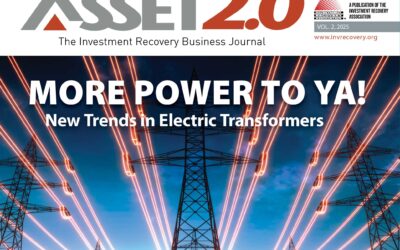Doing business in a way that’s good for People, the Planet, and Profits—and as surplus management professionals, we’re in the middle.
My journey with Investment Recovery (IR) and the Investment Recovery Association began in 2007. At first, I thought IR was only about the revenue, but as I dug deeper to evaluate exactly what we were doing at Duke Energy, it became apparent to me that we were operating one heck of a giant recycling operation. Tens of thousands of tons of scrap metal, wire, cable,
transformers, oil, and the list goes on. This stuff wasn’t junk—this was sustainability and recycling in action. Wow! Who would have ever thought that working for a regulated utility would suddenly become a journey in “Green”?
My title at Duke Energy is, appropriately enough, Manager, Investment Recovery & Recycling. The “& Recycling” represents an expanded function that ranges from simply disposing of assets and commodities to waste reduction and recycling for the overall non-hazardous waste stream. Our touchstone from the beginning is this: if we can recycle or repurpose material instead of putting it in a landfill for a cost that is less than or equal to the landfill, we consider that a more desirable alternative from both an economic and a sustainability point of view.
In 2014, I became active in the Electric Utility Industry Sustainable Supply Chain, also known as the “Alliance,” or EUISSCA. The purpose of the Alliance is to find and develop opportunities to continue to advance sustainability in the supply chain. The Alliance’s membership consists of approximately 15 investor-owned and public utilities across the United States. The membership’s geographic and ownership diversity brings a unique perspective to the sustainability journey, as each is influenced by regulators, customers, suppliers, and utility commitment to corporate sustainability.
The Alliance is committed to developing and publishing a “Utility Best Practice” each year. In 2015, “Investment Recovery” was chosen as the area of focus, and I was fortunate to lead a team of representatives from Duke Energy, Ameren, DTE, Eversource, Exelon, and Oklahoma Gas & Electric to develop best practices and author a white paper. If you think about it, investment recovery for the utility supply chain has a significant opportunity to champion sustainable material disposition, more so than most other areas in the supply chain. To begin the best practice development process, the team and I conducted interviews with Alliance members, participated in a “speed dating” exercise during the 2015 Investment Recovery Association (IRA) conference in Chicago to get IRA input, developed an initial list of approximately 100 sustainable practices for consideration, and ultimately synthesized these concepts into the overarching themes discussed below.
Although not included as an investment recovery sustainability best practice, our team recognized that selling equipment or material for reuse is a primary investment recovery function. Most Investment Recovery organizations would rather sell or repurpose equipment and materials prior to disposition by recycling or other disposal outlet, based on sound economics and individual utility-specific tolerances for environmental, safety, security, legal, branding, and other concerns. Reuse or repurpose of material or equipment offers the highest level of sustainability and economic common sense: we’re avoiding the waste stream, and this is what we all try to do. Once the utility has made the decision not to resell or repurpose the equipment or materials, the following Alliance sustainability recommendations are provided for consideration during the disposition process:
1. Incorporate desirable sustainability practices in the investment recovery bidding process:
Since most of the IR revenues and weights (65–75 percent) are generated by the sale of scrap commodities, the most significant sustainability opportunities will be in the bidding process and development of contracts for scrap commodities. Sustainability should have a seat at the table, along with other company partners, such as Finance, Legal, and Safety. We all use a variety of criteria to select our vendor partners, but for most IR organizations, economics is the factor that outweighs others by a significant margin. Other considerations when selecting vendors:
- Recycling by-products—the non-metal components of the commodity. What will the vendor do with this material? Is there further opportunity for downstream recycling, or will the non-metal portion of the scrap commodity be simply landfilled?
- Where will your commodities actually be processed? Domestically? Outsourced to a third world country? Will sustainability be considered by your vendor when processing and preparing the material into the final commodity? What happens to the non-commodity waste streams? Is your company at risk for negative publicity for poorly managed downstream disposal processes?
- Diversity—It used to be when we talked about diversity, IR wasn’t a factor, because we were selling instead of buying. There is a very logical way to incorporate vendor diversity with IR activities. True, we’re selling scrap commodities to a vendor, but most vendors provide a wide range of services, including services for which you pay (containers for scrap collection, labor, and logistics, processing the material), and the commodity for which you receive economic remuneration. Using diverse vendors to manage these scrap commodities should be included in corporate diversity goals.
2. Measure waste reduction and recycling improvement:
The Alliance made the case that IR should have a significant role in supporting, developing or managing waste reduction and recycling improvement measures. Depending on your company, a significant percentage of the materials that are recycled and diverted from the landfill are managed through your IR organization. Some IR organizations manage waste wood for recycling—Duke Energy and Oklahoma Gas & Electric come to mind. Does your company have a waste reduction or recycling goal? Does your IR department play a significant role in the development and reporting of this number? Wood, metal, wire, transformers, lighting, meters, oil, and electronics are all materials that are typically or potentially managed through IR. At Duke Energy, approximately 90 percent of the weight of all recycled materials, excluding coal combustion by-products, are managed by Investment Recovery. Why wouldn’t Investment Recovery participate, if not take a lead role, in developing this measure and reporting for improvement?
There are many ways to measure waste reduction and recycling improvement. The following calculation represents a simple diversion metric:
Understand total waste: Total Landfill (weight) + Total Recycling (weight) = Total Waste Stream (weight)
Calculate the diversion rate: Total Recycling / Total Waste Stream = Total Recycling % (or diversion rate)
3. Align investment recovery with other supply chain functions to improve performance and reduce waste:
It is amazing and frustrating to learn how many of our supply chain colleagues don’t know that IR is an integral part of their organization. Sometimes IR is just an afterthought, which is a critical loss for companies wanting to improve sustainability and reduce waste. Taking time to educate and then leverage our Supply Chain colleagues will go a long way towards reducing waste and enhancing economic returns. Think about it— our goal should not be to recycle more. Our goal should be to waste less and throw away less. While certainly one of the main goals for the IR function is to generate revenue, other goals are also in play: waste reduction, recycling, and legal and environmental protections. Many supply chain sustainability opportunities are potentially interconnected and discussions should include IR throughout the procurement process.
- Do your procurement personnel routinely negotiate buy-back options for material?
- Is the material planning process effective in sending the correct signals for the correct material? Do you have overages and underages that potentially create surplus and waste on the back-end?
- Do your warehouses talk to each other? How about regions? Do you have a good way to better manage material overages and underages with other utilities?
- Alignment of the investment recovery function with organizations outside of the supply chain and/or company:
Inside your company, there are significant opportunities to improve sustainability performance by engaging and educating employees about investment recovery for waste reduction and recycling improvement. Most people don’t really consider these factors when throwing material away. Without thoughtful management, waste disposal usually takes the path of least resistance and an out-of-sight, out-of-mind mentality. Just throwing material in a landfill has a substantial cost in terms of dumpster rental, labor to move material to the dumpster, various logistics, and environmental and tipping fees. Education goes a long way to facilitate understanding and modify behavior.
External to the company, sustainability dominates a significant share of the education and shared learning discussion. Think about the conferences you have attended or will attend, such as UPMG, USMA, Rapid, IRA, and many others. Almost all of these conferences will include a significant component or mention of sustainability. Investment Recovery is an important partner in these discussions and it’s up to you to make sure that you have a seat at these tables.
4. Consider alternative disposal practices:
Besides selling materials through typical contracts, there are alternative disposal practices that create additional sustainable opportunities to add to or enhance the bottom line. Most surplus furniture has very little economic value, especially furniture with a past life in utility operations. There are literally thousands of national and local organizations that will benefit from your low-value or no-value waste streams, including Goodwill Industries and Habitat for Humanity. These two are but a fraction of the charitable organizations that might benefit from our waste streams in a way that helps our organizations and the community. Work with your company to engage your local shelters, schools, or other charitable organizations to develop a mutually beneficial plan.
In conclusion
Very few groups or organizations have the potential to positively impact sustainability as much as investment recovery:
- We manage contracts that potentially compose 90% of the recycling tonnage for the organization. There are plenty of opportunities to manage these contracts to benefit both sustainability and economic returns.
- As the contract owner for such substantial volumes of recyclable materials, it makes sense that investment recovery should have a voice and seat at the waste reduction and recycling table.
- The greatest impact for waste reduction is to eliminate the waste stream altogether. The procurement function has an enormous opportunity to return unused material to the vendor. Effective material planning will help eliminate waste by planning for the right material in the right amounts at the right time.
- Don’t overlook opportunities to align investment recovery inside the organization through engaging and educating employees about the surplus waste stream, and aligning and engaging with other utility supply chain alliances and organizations.
- Take advantage of opportunities to liquidate certain surplus materials using alternative disposal venues that not only benefit the utility but benefit charitable organizations and the communities where we operate.
Investment recovery is in a unique position to operate as the main linchpin of a successful, sustainable supply chain. It’s not much of a stretch to move from a purveyor of junk to an investment recovery group that does business in a way that’s good for People, the Planet, and Profits.




